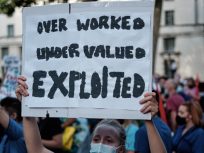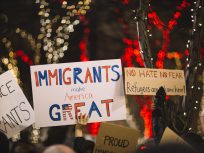
For much of the 20th century African American women with few other job opportunities dominated this occupation. The history of slavery and economic exploitation combined with a culture of servitude embodied in the fictionalized “mammy” stereotype made African American women the ideal household workers in the eyes of white Americans.
Yet, African American women resisted their working conditions and the image of the loyal and content worker in numerous ways. African American household workers have a very long history of labor organizing, which dates back to the 19th century. In 1881, 3000 African American washer women in Atlanta went on strike to raise their rates of pay and in the process nearly shut down the city. In the 1930s in the midst of the Great Depression, domestic workers organized advocacy groups and unions around the country to fight for better wages and an end to exploitation. And in the post-WWII period, African American household workers formed a national organization, the Household Technicians of America (HTA).
The HTA was a nationwide organization with chapters all across the country and a membership of 25,000. They fought for better working conditions, higher rates of pay, federal minimum wage protection, and greater respect for their work. They refused to be called maids, or servants, or the help, and preferred the term “household technician” because it signified the skilled-based nature of the work.
These activists used storytelling and historical narratives as a movement-building strategy. Their stories tied the occupation to the longer history of African American women’s labor as they spoke of their mothers, aunts, and grandmothers who also worked in this field. Storytelling became a way to build a political constituency, to develop a political identity and to draw women into the movement.
It also became a way to develop standards of reform. Geraldine Miller, for example, who lived in the Bronx, told stories of the Bronx Slave Markets—street corners where unemployed African American women stood to be hired for day work during the Great Depression. Miller had never experienced the slave market but she shared the example of how employers looked for women who had the “most-scarred knees” because this was an indication that they scrubbed floors on their hands and knees. Miller told this story partly to illuminate the history of exploitation, but also to encourage women to refuse to scrub floors down on all fours.
Household workers also shared stories of pride and of the value of this labor. And that distinguished this movement from both the mainstream civil rights movement—that rightly sought other employment opportunities for African American women—and the mainstream women’s movement that hoped to escape the drudgery of unpaid household labor for jobs outside the home. In contrast household workers sought to bring greater recognition, dignity and compensation to this occupation.
This movement emerged at a moment when the occupation was shifting. As Jim Crow laws were being dismantled, African American women increasingly found other kinds of work and a growing number of immigrant women entered the occupation. Household worker activists grappled with how to respond to the transformation in the workforce—and they ultimately decided that, rather than take a xenophobic position, they should reach out to and embrace the new immigrant workers. This, of course, challenges conventional wisdom that assumes tension, conflict, and competition between African American and immigrant workers. They weren’t always successful at building multi-racial, inter-ethnic coalitions, in part because at the moment they began to organize with immigrant workers, the movement itself was waning. Nevertheless, their willingness to do so is indicative of the expansive politics of this movement.
African American household workers won some important victories, perhaps most importantly passage of amendments to the Fair Labor Standards Act in 1974, which brought household workers under the federal minimum wage law from which they had been excluded since the 1930s. In addition, they exposed the ways the occupation of domestic service was tied to the long history of slavery and economic exploitation of African American women. The movement shattered the Mammy Myth. Despite these successes, however, broader shifts in the occupation—especially the turn to immigrant labor, redefined the occupation and created new forms of inequality within domestic service. So, even though household workers today have minimum wage protection, undocumented immigrant workers have a difficult time claiming this right. And home care attendants, a growing proportion of those doing in-home care, were excluded from the minimum wage legislation, but have been pushing for coverage in recent years. So, while the context for organizing is different today, the notion that household workers can organize, despite their isolation in the workplace and their relative disempowerment, is a lesson we can carry forward.
In the past two decades, domestic workers have once again taken to the streets. They are marching, protesting, shaming employers, and pushing for bills of rights as a form of labor protection. This organizing is part of what some observers have called the “new social movements”—grass-roots protest organizations that have emerged in the past few decades developed alternative labor organizing strategies. While this new organizing has made its mark on the political landscape, history shows us that earlier movements utilized similar, innovative approaches to labor organizing.
Recovering the voices of African American women household workers enables us to see a fuller history of this occupation. African American women were not the passive, fearful women embodied in the “mammy” stereotype or portrayed in Kathryn Stockett’s best-selling novel “The Help.” They were deeply immersed in civil rights activism, in challenging the power imbalance in their workplace, in bringing value and recognition to their labor, and in establishing a nationwide organization that served a platform for the voices of household workers. And they managed to transform the occupation in long-lasting ways that activists today are able to build upon and draw inspiration from. Women like Barbara Young, who is an organizer with the National Domestic Workers Alliance, reflected on the organizing of women like Dorothy Bolden in Atlanta: Those earlier instances of organizing “gave me hope that one day we would eventually succeed.”
Premilla Nadasen is an associate professor of history at Barnard College, Columbia University, and is the author of the recently published Household Workers Unite: The Untold Story of African American Women Who Built a Movement, and the award-winning Welfare Warriors: The Welfare Rights Movement in the United States. A longtime scholar-activist, Nadasen works closely with domestic workers’ rights organizations, for which she has written policy briefs and served as an expert academic witness.




